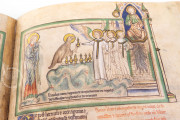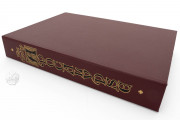Part of the Westminster group of English apocalypses, the Getty Apocalypse is rich in pictorial content and, unusual for a book about the end of time, a dash of levity in its depictions of John the Divine. Also called the Dyson Perrins Apocalypse after a previous owner, the book was executed in the International Gothic style originating in the French Court.
The pages are divided into two halves with the upper filled with delicate, detailed drawings colored sparingly and the lower reserved for two columns of text. The use of gold and silver is limited to details such as halos, crowns, and swords.
Made in Westminster or perhaps Salisbury, the book contains a Latin version of the Book of Revelations and, as was common, a commentary on the biblical text by Berengaudus. It is a charming example of a popular but brief manuscript tradition of illustrated apocalypses.
John the Divine Peeking at Things to Come
The forty-one half-page illuminations illustrate the visions described in the Book of Revelations unambiguously without drawing excessively on the commentary. While the figural style is very much French Gothic, the medium of tinted pen drawing looks back to an Anglo-Saxon aesthetic.
Most of the pictures include a figure of John, the author of the text, witnessing the events of the end of days as they unfold. Sometimes he is placed within the frame although not directly interacting with the nearby visions. However more often he is drawn outside the frame peeking in through an opening or window. Despite the seriousness of the subject matter, a certain delight was had by the artist when portraying John and his reactions to what he is seeing, even on one page showing him from behind.
Revelations in Black, Commentary in Red
Apocalypse manuscripts are often two separate texts, the biblical Book of Revelation and its accompanying commentary by Berengaudus. The difficulty for scribes is how to write the much shorter biblical verses and the much longer commentary in a way that keeps the sacred text separate and clear while still allowing for the inclusion of the interpretation.
In the Getty Apocalypse, the biblical text is written in black ink and Berengadus’s commentary in red, both in Gothic Precissa script. Elaborately decorated capitals begin each biblical verse, most with vegetal infill and a few with figural vignettes. The commentary’s capitals are smaller, gilded, and brightly colored throughout.
A Prized Possession for Private Collectors
Little is known about the Getty Apocalypse before it came to be owned by Charles Fairfax Murray, the painter and collector, sometime in the late nineteenth century. Although much of his collection was given to public institutions, the manuscript came to be owned by Charles William Dyson Perrins, another Victorian collector.
He had an extensive manuscript collection that was sold after his death in 1958. Hans P. Kraus Sr. and Peter Ludwig both owned the book before it was purchased for the J. Paul Getty Museum in 1983.
We have 1 facsimile edition of the manuscript "Getty Apocalypse": Getty Apocalypse facsimile edition, published by The Folio Society, 2011
Request Info / Price






















